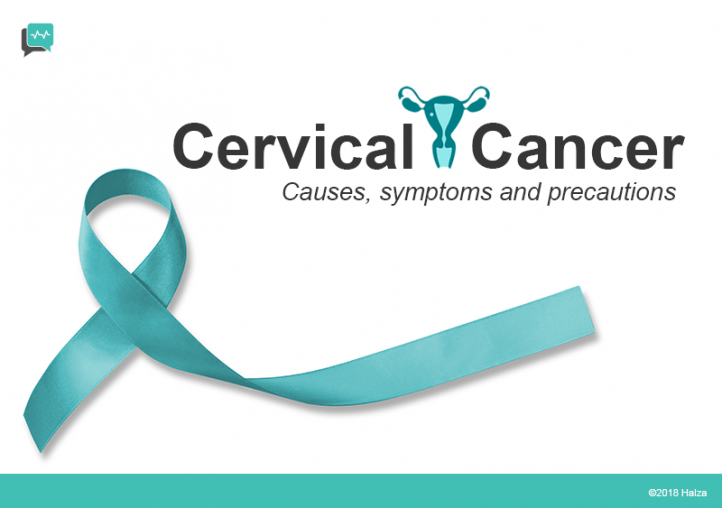Cervical Cancer: All You Need to Know

Cervical cancer occurs in the cells of the cervix – the lower part of the uterus that connects to the vagina – when healthy cells acquire a mutation that results in development and subsequent multiplication of abnormal cells.
In the early stages, the cancer cells grow from the surface into deeper tissues of the cervix, eventually invading into the body of the uterus. If left undetected and untreated, these can spread to the lymph nodes, the lower part of the vagina, walls of the pelvis and later surrounding structures like the internal urine tubes, urinary bladder & rectum. In advanced stages, it spreads to distant organs beyond the pelvic area, such as distant lymph nodes, lungs, bones or liver.
Across the world, cervical cancer is the fourth most common form of cancer diagnosed in women (2012). Here below is a list of what you need to know about the disease, and how you can prevent yourself from getting it.
What causes cervical cancer?
Human papillomavirus (HPV) is found in about 99% of cervical cancer cases, transmission of which occurs during sexual contact, be it vaginal, oral or anal with an infected person, who may or may not show the signs or symptoms of infection. Penetrative intercourse is not a must, skin-on-skin contact between genitals is sufficient enough to aid transmission.
The following can increase one’s chances of getting HPV & cervical cancer:
· Multiple sexual partners
· Being sexually active at an earlier age
· Concurrent occurrence of other sexually transmitted infections
· A weak immune system, especially an HIV infection
· Heavy Smoking
So, what is Human Papilloma Virus (HPV)?
 HPV is one of the common sexually transmitted infections (STI). Many sexually active people have been infected with HPV at some point in their lives, but may not have developed symptoms or signs, some not even in their entire lifetime.
HPV is one of the common sexually transmitted infections (STI). Many sexually active people have been infected with HPV at some point in their lives, but may not have developed symptoms or signs, some not even in their entire lifetime.
There are over 100 types of HPV’s, and only certain “high risk” types have been linked to cancers of the cervix in women, penis in men and also cancers of the mouth, throat, and anus in people of both sexes. ‘Low risk’ types can cause harmless growth on the skin or the genitals called viral warts.
HPV infection has no cure, however, the abnormal cells produced as a consequence of this infection can be dealt with. Periodic Pap smears are helpful in detecting early cancerous changes in the cervix of sexually active women.
Currently, there is no HPV detection test for men, therefore it is difficult to determine which partner passed the infection.
How do I know if I have Cervical cancer?
Usually, early-stage cervical cancer is symptom-free. As the cancer progresses into nearby tissues, the following symptoms may be noted:
- Bleeding after intercourse, between periods or after menopause
- Vaginal discharge with unpleasant odor or color
- Pain during sex or pelvic pain
In more advanced cancer you could have:
- Loss of appetite
- Weight loss
- Fatigue
- Back pain
- Bone pain
- Leg pain or swelling
- Jaundice
- Leakage of urine or feces from the vagina

When should I seek medical advice?
It is best to get checked by your doctor when you are experiencing any of the above-mentioned symptoms.
If your doctor suspects cervical cancer, he is likely to proceed with a thorough examination of your cervix and may suggest further tests to confirm cancer and to evaluate the cancer spread.
What are my options if I have Cervical cancer?
Depending on the type and stage of your cervical cancer, you may need more than one type of treatment. Treatment options available for cervical cancer include surgery, radiation therapy, and chemotherapy or a combination of any of these.
Early-stage cervical cancer is typically treated with surgery to remove the uterus. Radiation therapy helps to shrink the size of the tumor and may be used alone or in combination with chemotherapy/surgery. Advanced cervical cancer may be controlled with palliative chemotherapy.
How do I protect myself against Cervical cancer?
Prevention of cervical cancer includes the following 2 main points:
1. Pap test & HPV DNA test– Early Stage cervical cancer usually produces no symptoms. That’s why it’s important for women to have regular screening.
2. HPV vaccination-– The HPV vaccine is recommended for girls and boys at 11-12years, but is approved to be administered from 9 to 26 years old. Some countries also recommend people up to 45 years of age be vaccinated as the protection provided is against many strains of HPV. For optimal protection, however, it should be given before the onset of sexual activity
What about HPV vaccination for boys?
Boys need the HPV vaccine, too. Here’s why:
- HPV infections that don’t go away can cause cancers of the anus, rectum, mouth, throat and penis in men.
- There are no screening tests for these cancers, so they are often detected at an advanced stage when they are more difficult to treat.
- HPV vaccine is recommended for boys at 11 – 12 years, before onset of sexual activity.
Ask your doctor for more information on your next visit!
Source: Cancer.org – Webmd.com

Ready to test your knowledge about cervical cancer?
